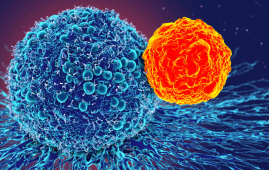

A new analysis of the brain activity of people with post-traumatic stress disorder (PTSD) is the first to reveal that traumatic memories are represented in the brain in an entirely different way than sad autobiographical memories.
This finding lends support to the idea that traumatic memories in PTSD are a distinct cognitive entity distinct from regular memory, and it may provide a biological explanation for why the recall of traumatic memories frequently manifests as intrusions that differ significantly from “regular” negative memories in PTSD patients.
The study, conducted by researchers at Mount Sinai’s Icahn School of Medicine and Yale University and published in Nature Neuroscience on November 30, was also the first to examine people’s real-life personal memories rather than basic cognitive mechanisms in order to link personal experience to brain function.
“For people with PTSD, recalling traumatic memories frequently manifests as intrusions that differ profoundly from processing of’regular’ negative memories,” said Daniela Schiller, Ph.D., Professor of Psychiatry and Neuroscience at Icahn Mount Sinai and senior author of the paper.
“Our findings indicate that the brain does not treat traumatic memories like regular memories, or even as memories at all.” We discovered that while recalling a stressful experience, brain areas believed to be important in memory are not active. This discovery presents a neuronal target for restoring traumatic memories to a brain state similar to ordinary memory processing.”
Previous study has proven that the hippocampus, a brain area, affects the generation and retrieval of episodic memories. PTSD is associated with anatomical abnormalities (most notably a decrease in volume) of the hippocampus, and hippocampal functions are central to PTSD pathophysiology.
The posterior cingulate cortex (PCC) has been shown to play an important role in narrative interpretation, autobiographical processing, and, in particular, emotional memory imagery. PTSD is characterized by changes in PCC function and connections.
To determine whether and how the hippocampus and posterior cingulate cortex distinguish traumatic autobiographical memories from sad ones, 28 PTSD patients underwent autobiographical memory reactivation using script-driven imagery while undergoing functional magnetic resonance imaging (fMRI).
To begin, the researchers employed an imagery development process to generate stimuli based on the subjects’ particular autobiographical memories. The “PTSD” condition: the traumatic memory associated with their PTSD (e.g., combat, sexual assault, domestic violence), the “sad” condition: a sad, meaningful, but non-traumatizing experience (e.g., death of a family member or pet), and the “calm” condition: a positive, calm event (e.g., memorable outdoor activities).
These highly intimate depictions of autobiographical memory were then carefully assembled into a 120-second audio clip narrated by a member of the research team. Notably, the PTSD and sad storylines were written to be structurally identical to one other in order to control for content and arousal. While undergoing functional magnetic resonance imaging, participants listened to this innovative portrayal of their own memories for the first time.
The team expected that semantic similarity between PTSD individuals would equate to neurological similarity: if two participants’ personal recollections are semantically similar, their patterns of neural responses when listening to audio recordings of these memories should be comparable as well.
If traumatic and sad memories are simply distinct types of autobiographical recollections, the researchers expected to find semantic-to-neural connectivity between pairs of traumatic and sad memories. However, if traumatic autobiographical memories differ from sad autobiographical memories rather than being a version of them, then they would only observe the semantic-to-neural link for sad, but not traumatic, memories.
The discovery that patterns in the hippocampus demonstrated a differential in semantic representation by story genre piqued the researchers’ interest. Sad scripts that were semantically identical across subjects generated similar brain representations on fMRI in the hippocampus. Thematically identical traumatic autobiographical recollections, on the other hand, did not generate similar images.
Importantly, the researchers discovered a link between semantic content and neural patterns of traumatic tales in the PCC, a brain region that has lately been described as a cognitive bridge between external events and self representation.
The research identifies a neurological basis for the subjective experience of recalling a traumatic memory versus a routine recollection. According to the findings, a therapeutic goal aiming at “returning” the traumatic memory representation to a normal hippocampus representation may be advantageous.
more recommended stories
 T-bet and the Genetic Control of Memory B Cell Differentiation
T-bet and the Genetic Control of Memory B Cell DifferentiationIn a major advancement in immunology,.
 Ultra-Processed Foods May Harm Brain Health in Children
Ultra-Processed Foods May Harm Brain Health in ChildrenUltra-Processed Foods Linked to Cognitive and.
 Parkinson’s Disease Care Advances with Weekly Injectable
Parkinson’s Disease Care Advances with Weekly InjectableA new weekly injectable formulation of.
 Brain’s Biological Age Emerges as Key Health Risk Indicator
Brain’s Biological Age Emerges as Key Health Risk IndicatorClinical Significance of Brain Age in.
 Children’s Health in the United States is Declining!
Children’s Health in the United States is Declining!Summary: A comprehensive analysis of U.S..
 Autoimmune Disorders: ADA2 as a Therapeutic Target
Autoimmune Disorders: ADA2 as a Therapeutic TargetAdenosine deaminase 2 (ADA2) has emerged.
 Is Prediabetes Reversible through Exercise?
Is Prediabetes Reversible through Exercise?150 Minutes of Weekly Exercise May.
 New Blood Cancer Model Unveils Drug Resistance
New Blood Cancer Model Unveils Drug ResistanceNew Lab Model Reveals Gene Mutation.
 Healthy Habits Slash Diverticulitis Risk in Half: Clinical Insights
Healthy Habits Slash Diverticulitis Risk in Half: Clinical InsightsHealthy Habits Slash Diverticulitis Risk in.
 Caffeine and SIDS: A New Prevention Theory
Caffeine and SIDS: A New Prevention TheoryFor the first time in decades,.

Leave a Comment